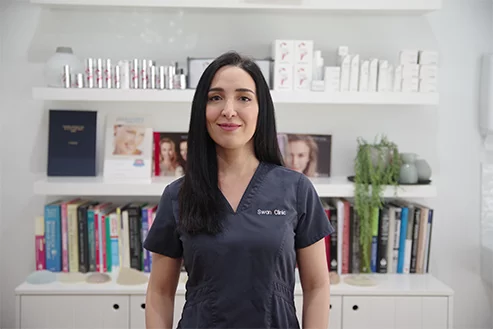Facial fat grafting (Autologous Fat Transfer to the Face)
Fat grafting is a surgical procedure that involves relocating fat from one area of the body to another to restore volume where it has diminished. The procedure may offer benefits for both the donor site and the treated area. Studies suggest that a percentage of the transferred fat may survive long term, although individual results can vary.
Common areas treated with fat graft include the cheeks, nasolabial folds, and marionette lines. This method can be an alternative to implants, with its own risks and benefits that should be discussed during a consultation.
Fat can be harvested from the donor site of your choice, these include:
- Lower abdomen
- Upper abdomen
- The flank area
- Inside of thighs
- Outside of thighs
Fat can be transferred to:
- The temples
- The lower eyelid trough area
- The cheeks
- The nasolabials
- The marionettes
- The chin
- The bridge of nose
How is Fat Grafting Done?
Fat grafting begins with the removal of fat from a donor area using a thin cannula through a small (approximately 2mm) incision. The fat is carefully suctioned out without the use of heat, ultrasound, or laser technologies, which may affect cell viability.
Once collected, the fat is processed to help maximize the survival of fat cells. The processed fat is then injected in small amounts, often described as microribbons, into the target areas. This technique helps distribute the fat evenly and supports its integration into the surrounding tissues.
The transferred fat survives by establishing a blood supply through natural processes involving blood vessel growth and integration. The extent of fat survival and retention can vary between individuals.
Benefits of Fat Grafting
- Uses your own tissue for augmentation.
- Contains plasma and other components naturally present in fat.
- Includes cells that may support tissue health.
- Fat is typically available in sufficient amounts once harvested.
- Studies report that a portion of the transferred fat may survive long term.
- Can improve the appearance of the donor site.
- The procedure can be repeated if necessary.
Potential Risks – Facial Fat Grafting
While generally considered safe, all surgical procedures carry risks. It is important to understand both general and procedure-specific risks:
- Infection at either the donor or recipient site, which may require antibiotics or additional treatment
- Bruising, swelling, and tenderness, common at both the liposuction and injection sites
- Fat reabsorption, where some of the transferred fat is naturally broken down by the body; results may diminish over time and may require repeat procedures
- Asymmetry, where uneven fat survival or placement may lead to imbalanced facial appearance
- Overcorrection or undercorrection, depending on how much fat is retained
- Lumps, nodules, or irregularities under the skin due to uneven fat placement or fat necrosis
- Fat necrosis, where small areas of fat do not survive, leading to firmness or cyst-like lumps
- Changes in skin sensation, such as numbness or tingling, usually temporary but can be prolonged in rare cases
- Scarring, usually minimal and hidden in natural creases or small incisions at the donor site
- Allergic reactions, while rare, may occur due to anaesthetic agents or other materials used
- Anaesthesia-related risks, including complications from sedation or general anaesthesia, depending on the method used
Recovery and Aftercare – Facial Fat Grafting
Recovery after facial fat transfer can vary depending on the extent of the procedure and individual healing factors. Below is a general guide to what you can expect:
- Swelling and bruising in both the face and donor area (e.g. abdomen, thighs, or flanks) are common and typically resolve over 1-3 weeks
- Mild to moderate discomfort can be expected at both sites and is usually manageable with over-the-counter or prescribed pain relief
- Initial volume may appear excessive, as swelling and overfilling are part of the process - this usually settles over several weeks
- Avoid applying pressure to the face, including sleeping on your side or stomach, for at least 1-2 weeks
- Strenuous activity or exercise should be avoided for approximately 2-3 weeks, or as advised by your surgeon
- Smoking and alcohol should be avoided during recovery, as they can negatively impact fat survival and healing
- Incision care for the donor site will be discussed with you and should be followed closely to minimise scarring and promote healing
- Oral hygiene is important if fat was injected inside or around the mouth area
- Follow-up appointments are important to assess fat retention, healing progress, and long-term results
- Final results may take 3–6 months to fully develop, as swelling resolves and the transferred fat stabilises
- Touch-up treatments may be required, as some fat reabsorption is expected over time
If you have any questions or wish to discuss facial fat grafting options, please contact our clinic to schedule a consultation with Dr Reema Hadi.

